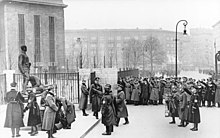Rosa-Luxemburg-Platz
This article needs additional citations for verification. (January 2023) |


Left Party
in 2007Rosa-Luxemburg-Platz, formerly the Bülowplatz, is a square in
Berlin-Mitte, Germany
.
History
The square is dominated by the
Berlin dialect to its unique character[1]
:
Ich komme uff'n Bülowplatz
und denke, wat is los?
der hat ja Polizeibesatz
Hier is 'ne Staatsaktion, mein Schatz!
Hier jibt's Zussammenstoss.
The square was previously named Babelsberger Platz (1907–1910) and Bülowplatz (1910–1933), and was the focus of one of the last mass demonstrations in Berlin against the
communist-controlled East Berlin, was renamed Liebknechtplatz (1945–1947) after German communist Karl Liebknecht. It was then renamed Luxemburgplatz (1947–1969) after communist leader Rosa Luxemburg, until it was given the name Rosa-Luxemburg-Platz by the East German
regime in 1969.

The square is noted as the scene of the
State Secretary in the newly formed Ministry of State Security.[2]
References
- ^ Azaryahu, Maoz (October 1986). "Street Names and Political Identity: The Case of East Berlin". Journal of Contemporary History. 21 (4): 584–585.
- ISBN 978-3-86676-141-4.
